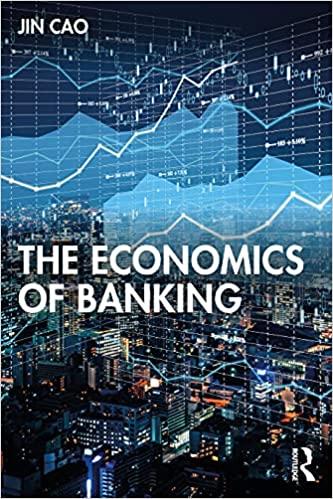Consider a one-period economy with a monopoly profitmaximizing bank that can invest in either of the following
Question:
Consider a one-period economy with a monopoly profitmaximizing bank that can invest in either of the following two types of assets:
- Good assets: one unit of safe asset yields a gross return \(G\) with probability \(p_{G}\) and 0 otherwise at the end of the period;
- Bad assets: one unit of bad asset yields a gross return \(B\) with probability \(p_{B}\) and 0 otherwise at the end of the period.
It is known that \(G
There is no deposit insurance available in this economy. Depositors are risk neutral and they take deposit contracts from the bank at the beginning of the period. Depositors get repaid at the end of the period with a gross interest rate \(R\) if the bank's assets return, otherwise depositors get nothing. There is no asymmetric information. To ease the computation, we further assume that the bank's participation constraint is always fulfilled.
(a) Provide a graphical illustration of how the payoffs of the two types of assets vary with \(R\), and compute the critical value of \(R\), denoted by \(\hat{R}\), below which the bank only invests in the good assets and above which the bank only invests in the bad assets. Compute \(\hat{R}\).
(b) Recall that there is no deposit insurance available in this economy; this implies that depositors are happy to deposit as long as their expected gross return from deposits is no lower than 1. As the bank is a monopoly, depositors earn zero profit from deposits. For the values of \(p_{G}, G, p_{B}\), \(B\), find a condition under which depositors are willing to deposit and the bank invests only in the bad project.
(c) Now the bank has a choice to hold an amount of capital \(k\) for each unit of asset. Therefore, for each unit of the bank's asset, the bank has to raise \(k\) from the shareholders and \(1-k\) from the depositors. The bank has to guarantee a return to equity (ROE) of \(ho(ho>0)\) for the shareholders, and we assume that the bank pays a gross return \(R\) for each \(1-k\) unit of deposit.
i. Suppose there is an \(R\) under which depositors are willing to deposit and the bank invests only in the bad assets. Compute \(R\) and the optimal level of capital for the profit-maximizing bank.
ii. Suppose, instead, there is an \(R\) under which depositors are willing to deposit and the bank invests only in the good assets. Compute \(R\) and the optimal level of capital for the profit- maximizing bank.
iii. Show there exists a threshold \(\hat{ho}\), such that for any \(ho<\hat{ho}\), the profit-maximizing bank chooses an optimal capital level \(k^{*}\) and invests only in the good assets. Compute \(\hat{ho}\) and \(k^{*}\).
Step by Step Answer:






